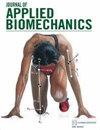肌肉扭矩-速度关系和疲劳与年轻人和老年人膝关节活动范围减小的关系。
IF 1.1
4区 医学
Q4 ENGINEERING, BIOMEDICAL
引用次数: 0
摘要
本研究旨在评估膝关节活动范围(RoM)对 7 名年轻人(中位数 = 26 岁)和 7 名老年人(68 岁)膝关节伸肌的扭矩-速度关系和疲劳的影响。每条腿都被分配了一个RoM(35°或75°),在此范围内进行扭矩-速度方案(最大等速收缩,60-300°-s-1)和疲劳方案(最大收缩120次,120°-s-1,0.5 Hz)。六名年龄较大的参与者无法达到 35° 以上的 300°-s-1。因此,通过拟合单个扭矩-速度曲线(60-240°-s-1),计算出每个 RoM 在 60°-s-1 时产生 75% 峰值扭矩的速度(V75,°-s-1),并确定 ΔV75(35°-75°)。疲劳(最终扭矩/初始扭矩)用于计算 Δfatigue (35°-75°)。年轻人(-28.3°-s-1 [-158.6至55.7],中位数[范围],P = .091)或老年人(-18.5°-s-1 [-95.0至23.9],P = .128)的ΔV75与0无差异,不同年龄无差异(P = .710)。与此相反,年轻人(Δfatigue = 25.9% [17.5-30.3],P = .018)和老年人(17.2% [11.9-52.9],P = .018)在 75°时的疲劳程度更大,年龄没有影响(P = .710)。这些数据表明,无论年龄如何,RoM 都不会改变 60 至 240°-s-1 扭矩与速度之间的关系,RoM 越大,疲劳越严重。本文章由计算机程序翻译,如有差异,请以英文原文为准。
Muscle Torque-Velocity Relationships and Fatigue With Reduced Knee Joint Range of Motion in Young and Older Adults.
The purpose of this study was to evaluate the influence of knee joint range of motion (RoM) on the torque-velocity relationship and fatigue in the knee extensor muscles of 7 young (median = 26 y) and 7 older (68 y) adults. Each leg was assigned a RoM (35° or 75°) over which to perform a torque-velocity protocol (maximal isokinetic contractions, 60-300°·s-1) and a fatigue protocol (120 maximal contractions at 120°·s-1, 0.5 Hz). Six older participants were unable to reach 300°·s-1 over 35°. Therefore, the velocity eliciting 75% of peak torque at 60°·s-1 (V75, °·s-1) was calculated for each RoM from a fit of individual torque-velocity curves (60-240°·s-1), and ΔV75 (35°-75°) was determined. Fatigue (final torque/initial torque) was used to calculate Δfatigue (35°-75°). ΔV75 was not different from 0 in young (-28.3°·s-1 [-158.6 to 55.7], median [range], P = .091) or older (-18.5°·s-1 [-95.0 to 23.9], P = .128), with no difference by age (P = .710). In contrast, fatigue was greater for 75° in young (Δfatigue = 25.9% [17.5-30.3], P = .018) and older (17.2% [11.9-52.9], P = .018), with no effect of age (P = .710). These data indicate that, regardless of age, RoM did not alter the torque-velocity relationship between 60 and 240°·s-1, and fatigue was greater with a larger RoM.
求助全文
通过发布文献求助,成功后即可免费获取论文全文。
去求助
来源期刊

Journal of Applied Biomechanics
医学-工程:生物医学
CiteScore
2.00
自引率
0.00%
发文量
47
审稿时长
6-12 weeks
期刊介绍:
The mission of the Journal of Applied Biomechanics (JAB) is to disseminate the highest quality peer-reviewed studies that utilize biomechanical strategies to advance the study of human movement. Areas of interest include clinical biomechanics, gait and posture mechanics, musculoskeletal and neuromuscular biomechanics, sport mechanics, and biomechanical modeling. Studies of sport performance that explicitly generalize to broader activities, contribute substantially to fundamental understanding of human motion, or are in a sport that enjoys wide participation, are welcome. Also within the scope of JAB are studies using biomechanical strategies to investigate the structure, control, function, and state (health and disease) of animals.
 求助内容:
求助内容: 应助结果提醒方式:
应助结果提醒方式:


